Uncertainty in the Number of Calibration Repetitions of a Hydrologic Model in Varying Climatic Conditions
Abstract
1. Introduction
2. Study Catchment and Data
2.1. Study Catchment
2.2. Data
2.3. Selection of Periods With Varying Climate
3. Methods
3.1. Hydrologic Model
3.2. Analysis of Uncertainty Resulting from a Different Number of Calibration Repetitions
4. Results
4.1. Uncertainty of Hydrologic Model Performance in Varying Climatic Conditions
4.2. Uncertainty in Hydrologic Model Parameters in Varying Climatic Conditions
4.3. Simulation of Runoff and Snow Water Equivalent in Varying Climatic Conditions
5. Discussion
6. Conclusions
Author Contributions
Funding
Acknowledgments
Conflicts of Interest
References
- Nester, T.; Komma, J.; Blöschl, G. Real time forecasting in the Upper Danube basin. J. Hydrol. Hydromech. 2016, 64, 404–414. [Google Scholar] [CrossRef]
- Farkas, C.; Kværnø, S.H.; Engebretsen, A.; Barneveld, R.; Deelstra, J. Applying profile and catchment-based mathematical models for evaluating the run-off from a Nordic catchment. J. Hydrol. Hydromech. 2016, 64, 218–225. [Google Scholar] [CrossRef]
- Beven, K.; Binley, A. The future of distributed models: Model calibration and uncertainty prediction. Hydrol. Process. 1992, 6, 279–298. [Google Scholar] [CrossRef]
- Beven, K.J.; Freer, J. Equifinality, data assimilation, and uncertainty estimation in mechanistic modeling of complex environmental systems using the GLUE methodology. J. Hydrol. 2001, 105, 157–172. [Google Scholar] [CrossRef]
- Beven, K. The limits of splitting: Hydrology. Sci. Total Environ. 1996, 183, 89–97. [Google Scholar] [CrossRef]
- Beven, K. A manifesto for the equifinality thesis. J. Hydrol. 2006, 320, 18–36. [Google Scholar] [CrossRef]
- Shen, Z.Y.; Chen, L.; Chen, T. Analysis of parameter uncertainty in hydrological and sediment modeling using GLUE method: A case study of SWAT model applied to Three Gorges Reservoir Region, China. Hydrol. Earth Syst. Sci. 2012, 16, 121–132. [Google Scholar] [CrossRef]
- Konz, M.; Seibert, J. On the value of glacier mass balances for hydrological model calibration. J. Hydrol. 2010, 385, 238–246. [Google Scholar] [CrossRef]
- Finger, D.; Pellicciotti, F.; Konz, M.; Rimkus, S.; Burlando, P. The value of glacier mass balance, satellite snow cover images, and hourly discharge for improving the performance of a physically based distributed hydrological model. Water Resour. Res. 2011, 47, W07519. [Google Scholar] [CrossRef]
- Finger, D.; Vis, M.; Huss, M.; Seibert, J. The value of multiple data set calibration versus model complexity for improving the performance of hydrological models in mountain catchments. Water Resour. Res. 2015, 51. [Google Scholar] [CrossRef]
- de Niet, J.; Finger, D.C.; Bring, A.; Egilson, D.; Gustafsson, D.; Kalantari, Z. Benefits of combining satellite-derived snow cover data and discharge data to calibrate a glaciated catchment in sub-arctic Iceland. Water 2020, 12, 975. [Google Scholar] [CrossRef]
- Sikorska-Senoner, A.E.; Schaefli, B.; Seibert, J. Downsizing parameter ensembles for simulations of extreme floods. Nat. Hazards Earth Syst. Sci. Discuss. 2020. [Google Scholar] [CrossRef]
- Parajka, J.; Blöschl, G. The value of MODIS snow cover data in validating and calibrating conceptual hydrologic models. J. Hydrol. 2008, 358, 240–258. [Google Scholar] [CrossRef]
- Finger, D.; Heinrich, G.; Gobiet, A.; Bauder, A. Projections of future water resources and their uncertainty in a glacierized catchment in the Swiss Alps and the subsequent effects on hydropower production during the 21st century. Water Resour. Res. 2012, 48, W02521. [Google Scholar] [CrossRef]
- Duethmann, D.; Peters, J.; Blume, T.; Vorogushyn, S.; Gunter, A. The value of satellite-derived snow cover images for calibrating a hydrological model in snow–dominated catchments in Central Asia. Water Resour. Res. 2014, 50, 2002–2021. [Google Scholar] [CrossRef]
- Parajka, J.; Naeimi, V.; Blöschl, G.; Wagner, W.; Merz, R.; Scipal, K. Assimilating scatterometer soil moisture data into conceptual hydrologic models at the regional scale. Hydrol. Earth Syst. Sci. 2006, 10, 353–368. [Google Scholar] [CrossRef]
- Razavi, S.; Tolson, B.A. An efficient framework for hydrologic model calibration on long data periods. Water Resour. Res. 2013, 49, 8418–8431. [Google Scholar] [CrossRef]
- Sorooshian, S.; Gupta, V.K.; Fulton, J.L. Evaluation of maximum likelihood parameter estimation techniques for conceptual rainfall–runoff models: Influence of calibration data variability and length on model credibility. Water Resour. Res. 1983, 19, 251–259. [Google Scholar] [CrossRef]
- Anctil, F.; Perrin, C.; Andréassian, V. Impact of the length of observed records on the performance of ANN and of conceptual parsimonious rainfall–runoff forecastting models. Environ. Model. Softw. 2004, 19, 357–368. [Google Scholar] [CrossRef]
- Brath, A.; Montanari, A.; Toth, E. Analysis of the effects of different scenarios of historical data availability on the calibration of a spatially-distributed hydrological model. J. Hydrol. 2004, 291, 232–253. [Google Scholar] [CrossRef]
- Merz, R.; Blöschl, G.; Parajka, J. Scale effects in conceptual hydrological modelling. Water Resour. Res. 2009, 45, W09405. [Google Scholar] [CrossRef]
- Merz, R.; Parajka, J.; Bloschl, G. Time stability of catchment model parameters: Implications for climate impact analyses. Water Resour. Res. 2011, 47. [Google Scholar] [CrossRef]
- Coron, L.; Andréassian, V.; Perrin, C.; Lerat, J.; Vaze, J.; Bourqui, M.; Hendrickx, F. Crash testing hydrological models in contrasted climate conditions: An experiment on 216 Australian catchments. Water Resour. Res. 2012, 48. [Google Scholar] [CrossRef]
- Brigode, P.; Oudin, L.; Perrin, C. Hydrological model parameter instability: A source of additional uncertainty in estimating the hydrological impacts of climate change? J. Hydrol. 2013, 476, 410–425. [Google Scholar] [CrossRef]
- Broderick, C.; Matthews, T.; Wilby, R.L.; Bastola, S.; Murphy, C. Transferability of hydrological models and ensemble averaging methods between contrasting climatic periods. Water Resour. Res. 2016, 52, 8343–8373. [Google Scholar] [CrossRef]
- Deng, C.; Liu, P.; Wang, D.; Wang, W. Temporal variation and scaling of parameters for a monthly hydrologic model. J. Hydrol. 2018, 558, 290–300. [Google Scholar] [CrossRef]
- Guo, D.; Johnson, F.; Marshall, L. Assessing the potential robustness of conceptual rainfall-runoff models under a changing climate. Water Resour. Res. 2018. [Google Scholar] [CrossRef]
- Vaze, J.; Post, D.A.; Chiew, F.H.S.; Perraud, J.M.; Viney, N.R.; Teng, J. Climate non-stationarity—Validity of calibrated rainfall–runoff models for use in climate change studies. J. Hydrol. 2010, 394, 447–457. [Google Scholar] [CrossRef]
- Coron, L.; Andréassian, V.; Perrin, C.; Bourqui, M.; Hendrickx, F. On the lack of robustness of hydrologic models regarding water balance simulation: A diagnostic approach applied to three models of increasing complexity on 20 mountainous catchments. Hydrol. Earth Syst. Sci. 2014, 18, 727–746. [Google Scholar] [CrossRef]
- Osuch, M.; Romanowicz, R.J.; Booij, M.J. The influence of parametric uncertainty on the relationships between HBV model parameters and climatic characteristics. Hydrol. Sci. J. 2015, 60, 1299–1316. [Google Scholar] [CrossRef]
- Saft, M.; Peel, M.C.; Western, A.W.; Perraud, J.M.; Zhang, L. Bias in streamflow projections due to climate-induced shifts in catchment response. Geophys. Res. Lett. 2016, 43, 1574–1581. [Google Scholar] [CrossRef]
- Fowler, H.J.A.; Peel, M.C.; Western, A.W.; Zhang, L.; Peterson, T.J. Simulating runoff under changing climatic conditions: Revising an apparent deficiency of conceptual rainfall-runoff models. Water Resour. Res. 2016, 52, 1820–1846. [Google Scholar] [CrossRef]
- Dakhlaoui, H.; Ruelland, D.; Tramblay, Y.; Bargaoui, Z. Evaluating the robustness of conceptual rainfall-runoff models under climate variability in northern Tunisia. J. Hydrol. 2017, 550, 201–217. [Google Scholar] [CrossRef]
- Sleziak, P.; Szolgay, J.; Hlavčová, K.; Duethmann, D.; Parajka, J.; Danko, M. Factors controlling alterations in the performance of a runoff model in changing climate conditions. J. Hydrol. Hydromech. 2018, 66, 381–392. [Google Scholar] [CrossRef]
- Stephens, C.M.; Marshall, L.A.; Johnson, F.M. Investigating strategies to improve hydrologic model performance in a changing climate. J. Hydrol. 2019, 579. [Google Scholar] [CrossRef]
- Ceola, S.; Arheimer, B.; Baratti, E.; Blöschl, G.; Capell, R.; Castellarin, A.; Freer, J.; Han, D.; Hrachowitz, M.; Hundecha, Y.; et al. Virtual laboratories: New opportunities for collaborative water science. Hydrol. Earth Syst. Sci. 2015, 19, 2101–2117. [Google Scholar] [CrossRef]
- Kostka, Z.; Holko, L. Soil Moisture and Runoff Generation in Small Mountain Basin. Institute of Hydrology SAS; Slovak Committee for Hydrology: Bratislava, Slovakia, 1997; 84p. [Google Scholar]
- Hlaváčiková, H.; Holko, L.; Danko, M.; Novák, V. Estimation of macropore flow characteristics in stony soils of a small mountain catchment. J. Hydrol. 2019, 574, 1176–1187. [Google Scholar] [CrossRef]
- Sleziak, P.; Danko, M.; Holko, L. Testing an alternative approach to calibration of a hydrological model under varying climatic conditions. Acta Hydrol. Slovaca 2019, 20, 131–138. [Google Scholar] [CrossRef]
- Viglione, A.; Parajka, J. TUWmodel: Lumped/Semi-Distributed Hydrological Model for Education Purposes. R Package Version 1.1-1. 2020. Available online: https://cran.r-project.org/web/packages/TUWmodel/index.html (accessed on 20 August 2020).
- Parajka, J.; Merz, R.; Blöschl, G. Uncertainty and multiple calibration in regional water balance modelling case study in 320 Austrian catchments. Hydrol. Process. 2007, 21, 435–446. [Google Scholar] [CrossRef]
- Ardia, D.; Mullen, K.M.; Peterson, B.G.; Ulrich, J. DEoptim: Diferential evolution in R. J. Stat. Softw. 2015, 40, 1–26. [Google Scholar] [CrossRef]
- Nash, J.E.; Sutcliffe, J.V. River flow forecasting through conceptual models part I—A discussion of principles. J. Hydrol. 1970, 10, 282–290. [Google Scholar] [CrossRef]
- Klemeš, V. Operational testing of hydrological simulation models. Hydrol. Sci. J. 1986, 31, 13–24. [Google Scholar] [CrossRef]
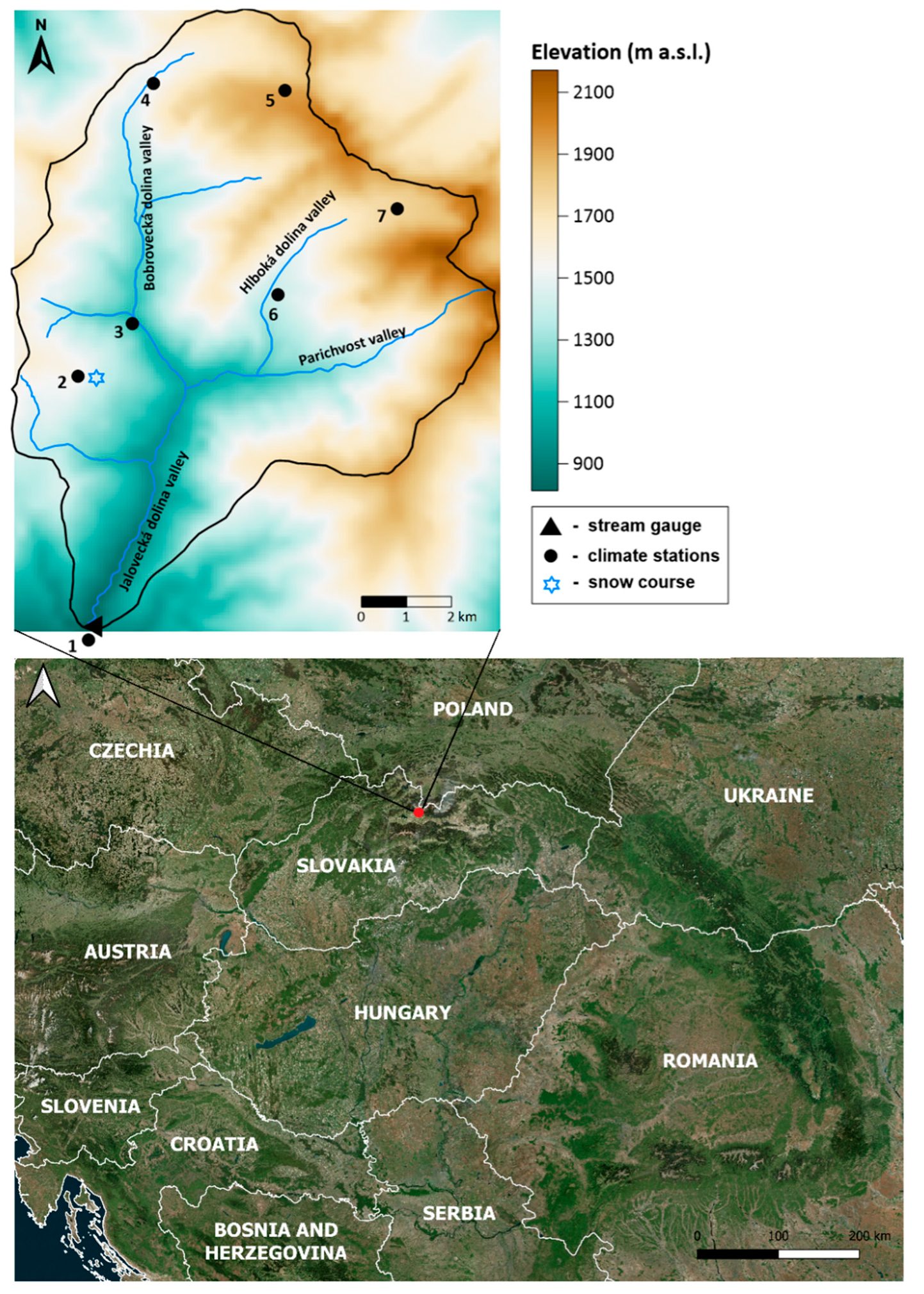
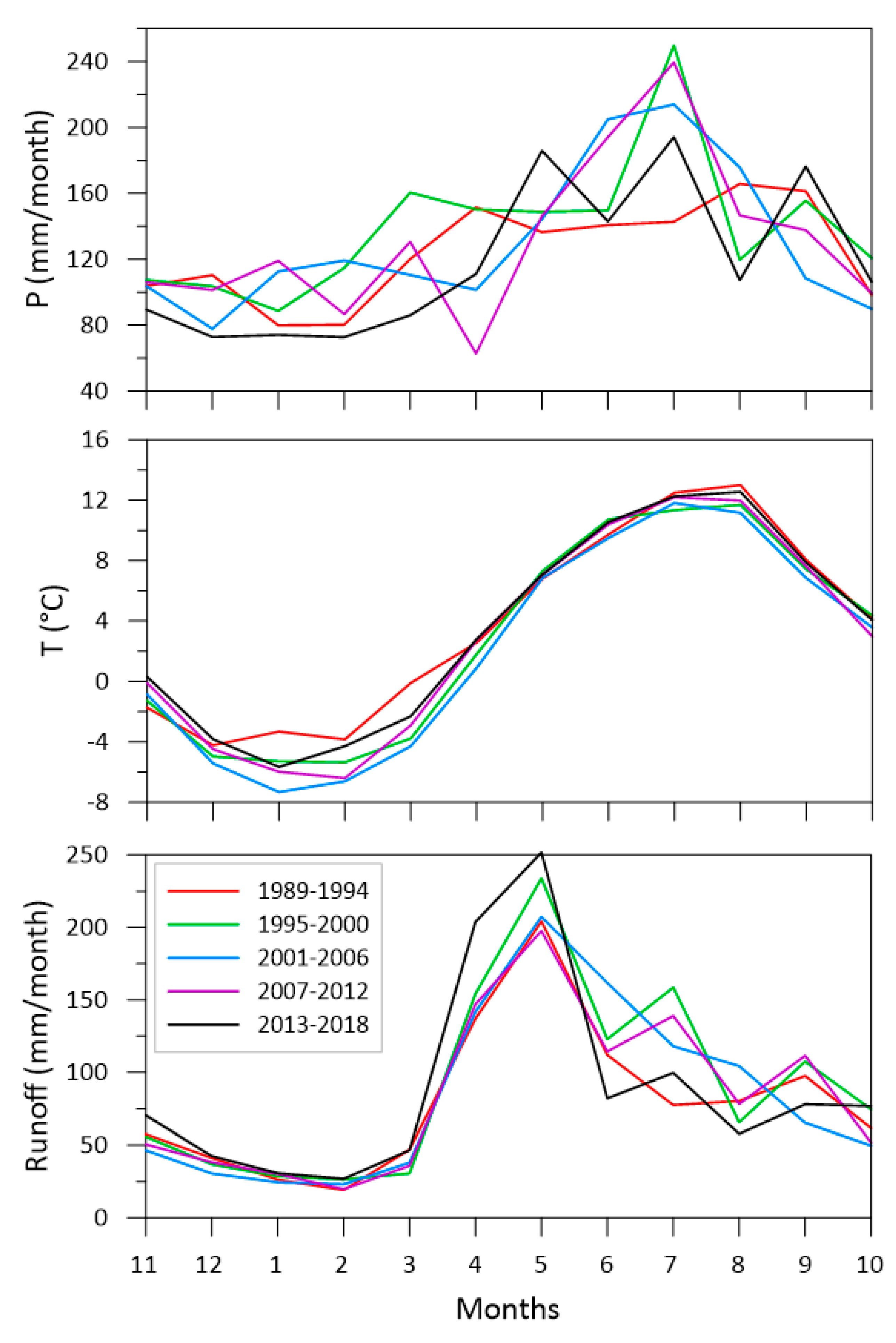
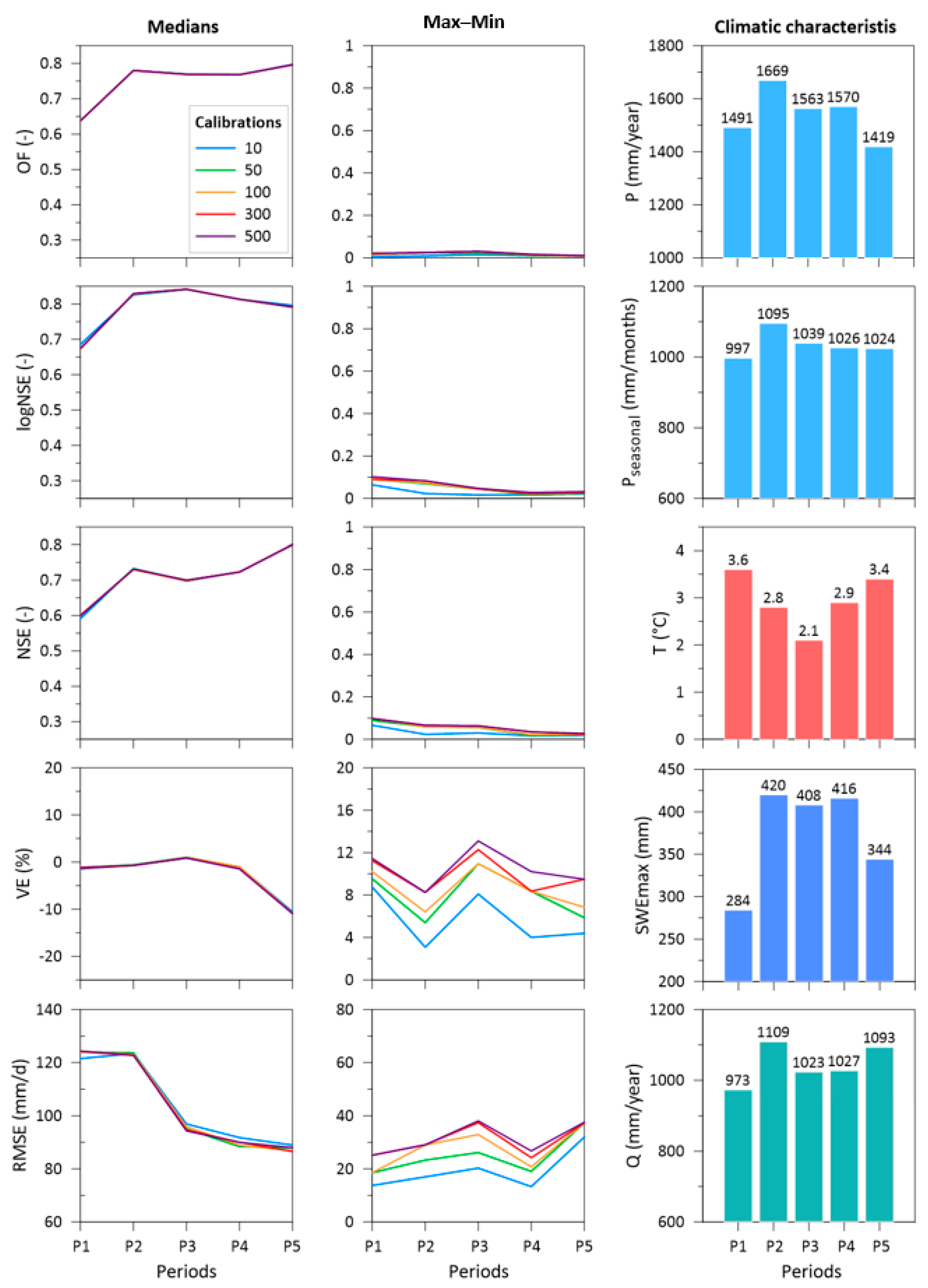
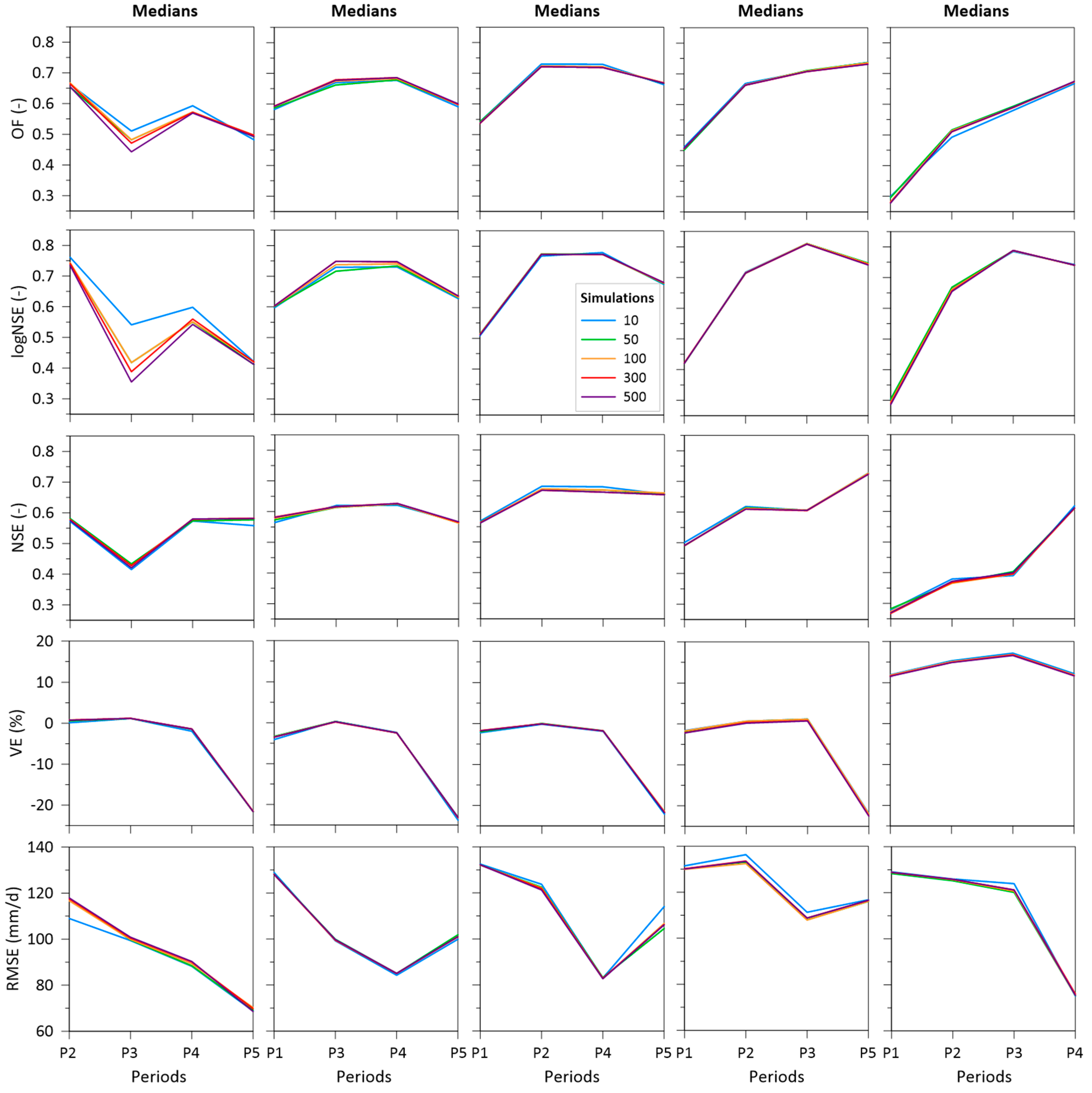
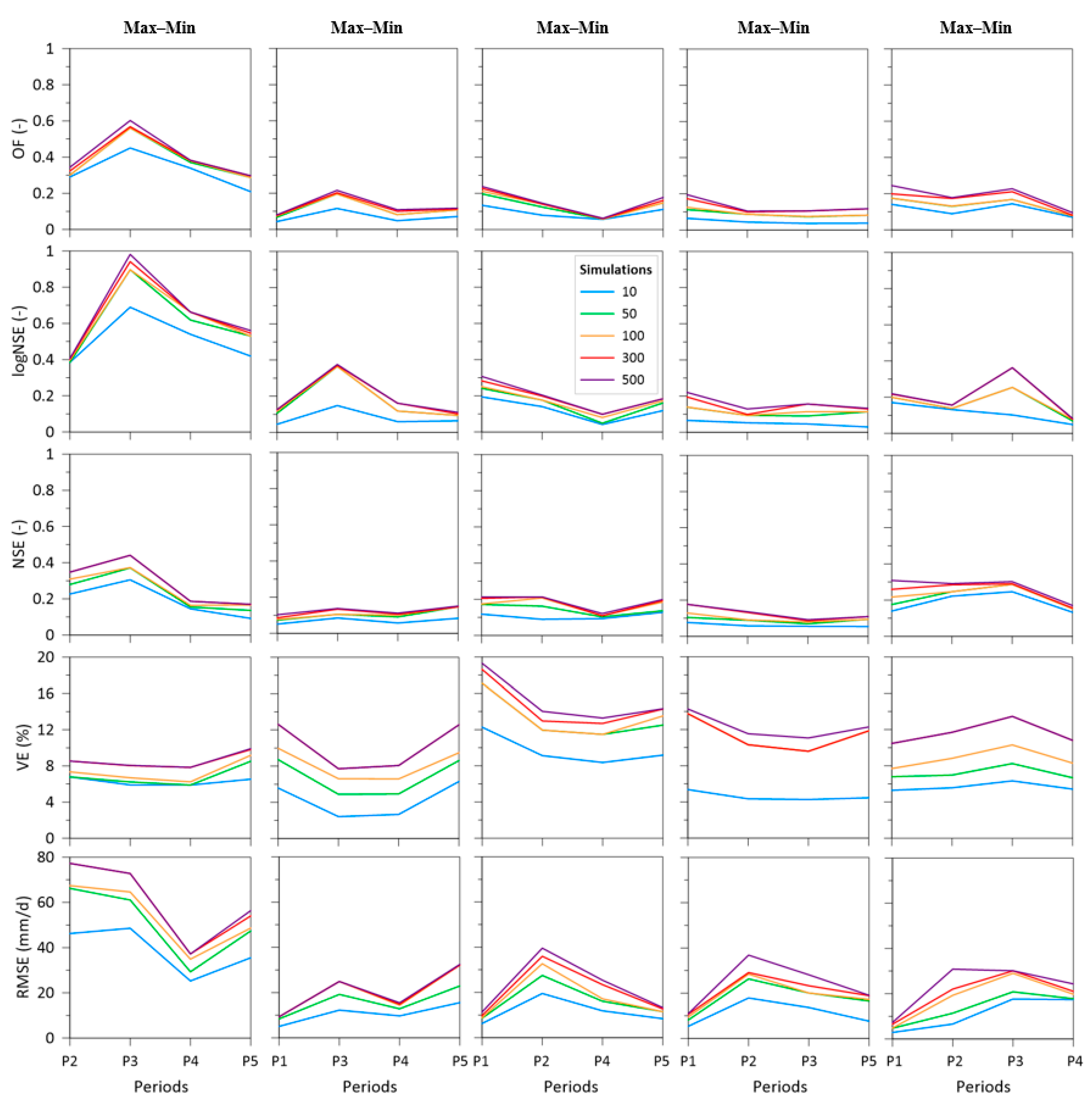
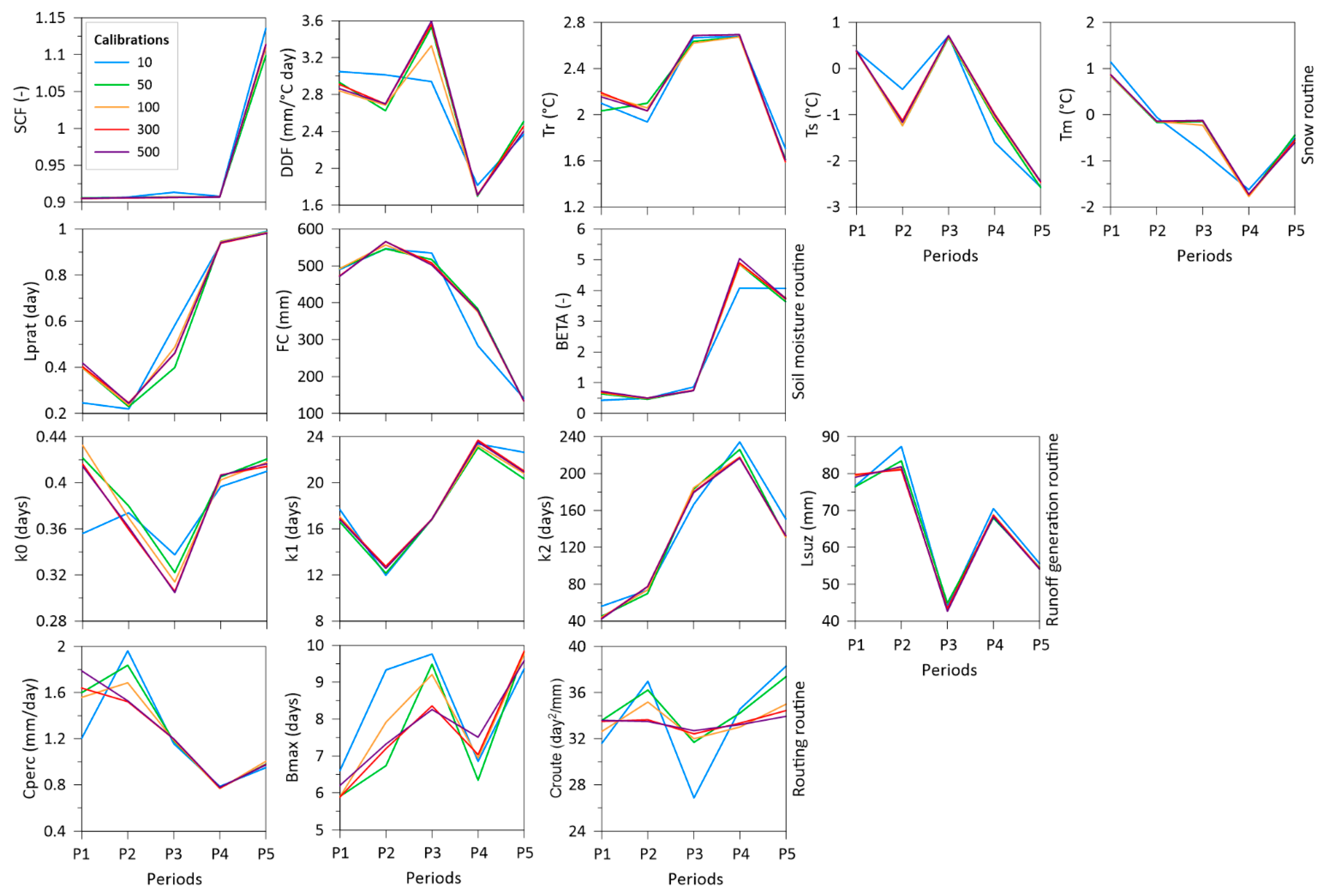
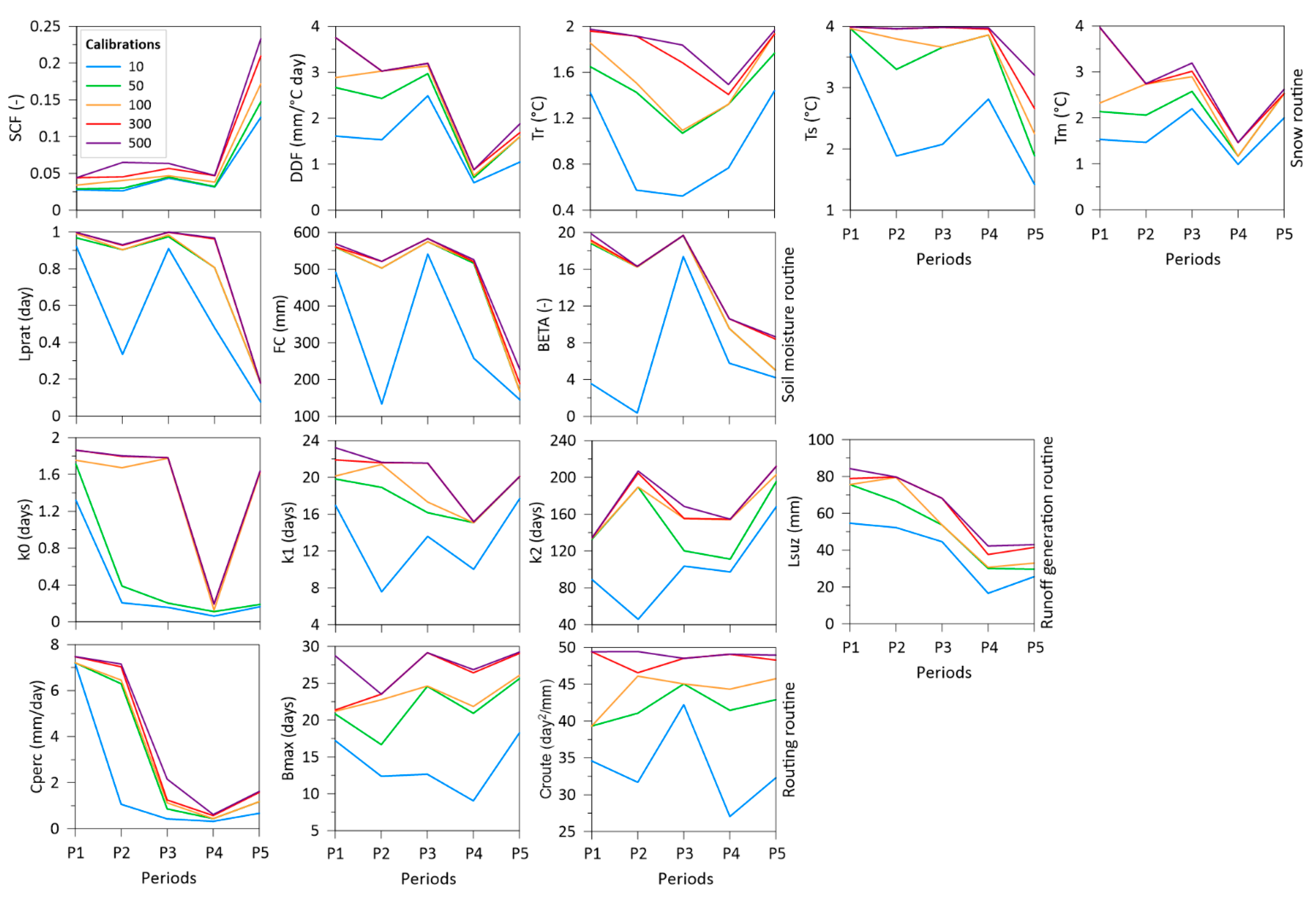
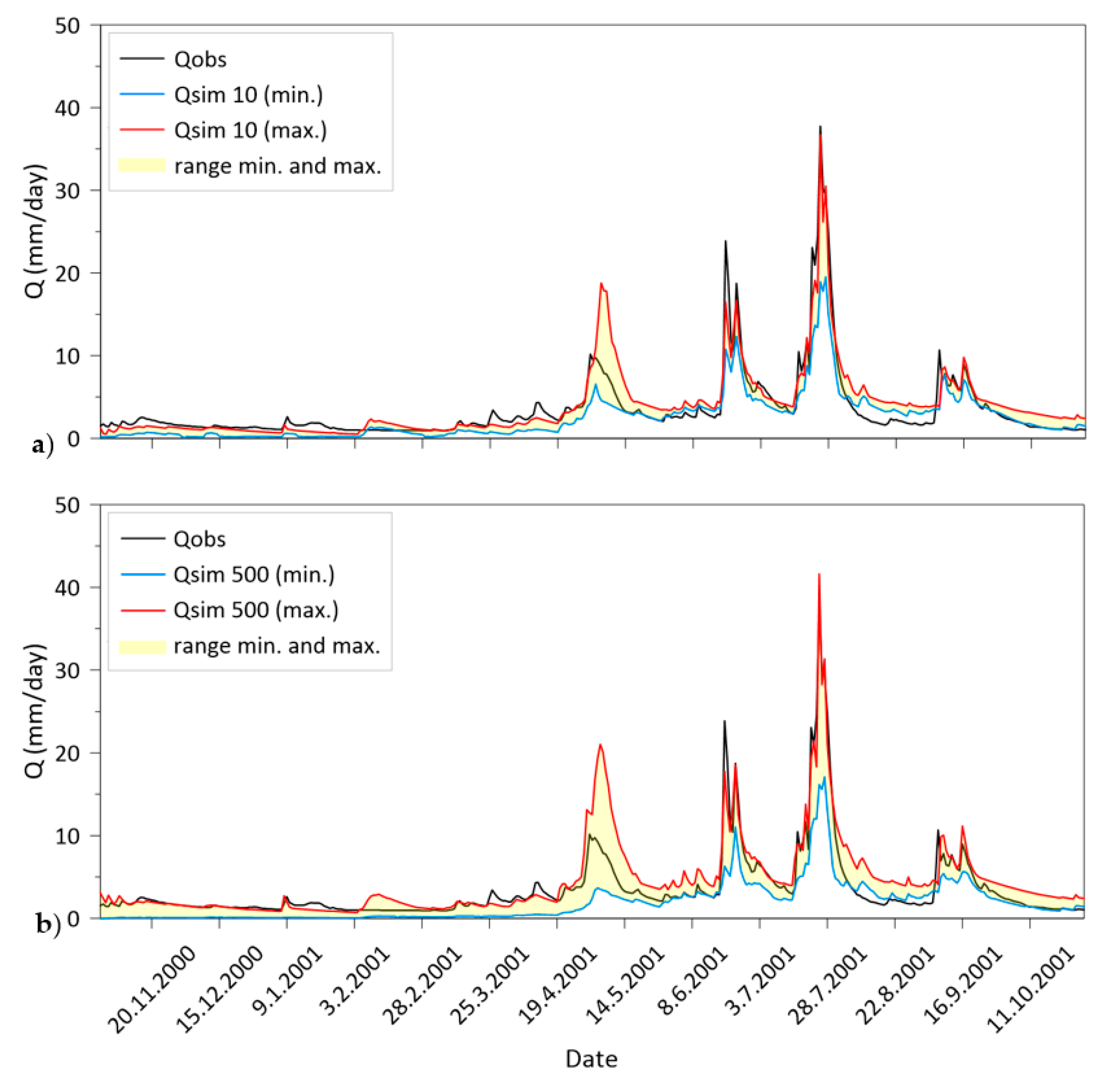
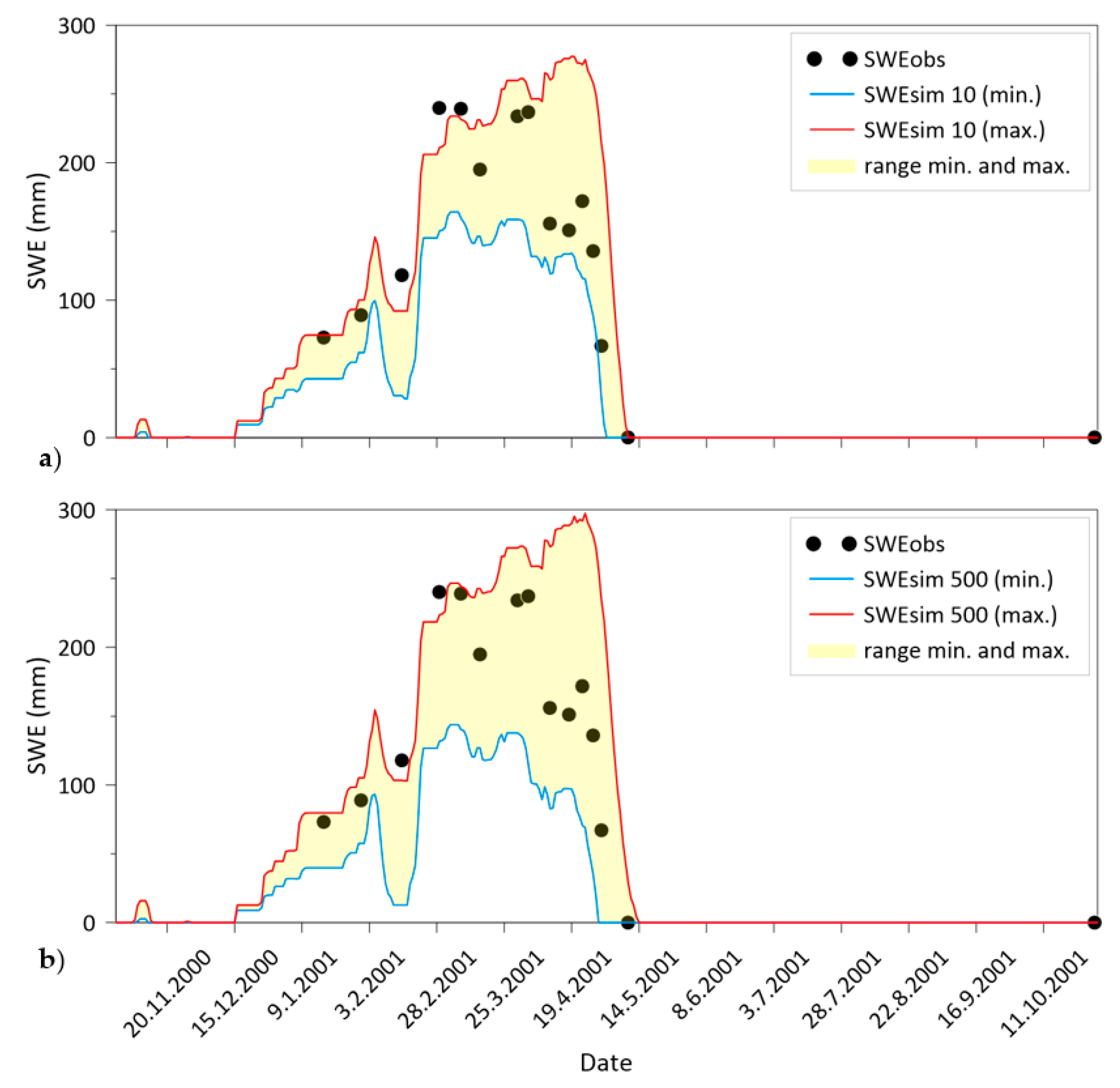
| Annual Characteristics | Seasonal Characteristics | |||||
|---|---|---|---|---|---|---|
| Period | P (mm/year) | T (°C) | Q (mm/year) | P (mm/) | T (°C) | SWEmax (mm) |
| 1989–1994 | 1491 | 3.6 | 973 | 997 | 8.1 | 284 |
| 1995–2000 | 1669 | 2.8 | 1109 | 1095 | 7.8 | 420 |
| 2001–2006 | 1563 | 2.1 | 1023 | 1039 | 7.3 | 408 |
| 2007–2012 | 1570 | 2.9 | 1027 | 1026 | 7.9 | 416 |
| 2013–2018 | 1419 | 3.4 | 1093 | 1024 | 8.2 | 344 |
| Parameter | Routine | Unit | Range |
|---|---|---|---|
| Snow correction factor (SCF) | Snow | 0.9–1.5 | |
| Degree-day factor (DDF) | Snow | mm/°C day | 0–5 |
| Rain threshold temperature (Tr) | Snow | °C | 1–3 |
| Snow threshold temperature (Ts) | Snow | °C | −3–1 |
| Melt temperature (Tm) | Snow | °C | −2–2 |
| Limit for potential evapotranspiration (Lprat) | Soil | day | 0–l |
| Maximum soil moisture storage (FC) | Soil | mm | 0–600 |
| Nonlinearity parameter (BETA) | Soil | 0–20 | |
| Very fast storage coefficient (k0) | Runoff | days | 0–2 |
| Fast storage coefficient (k1) | Runoff | days | 2–30 |
| Slow storage coefficient (k2) | Runoff | days | 30–250 |
| Upper storage coefficient (Lsuz) | Runoff | mm | 1–100 |
| Percolation rate (Cperc) | Routing | mm/day | 0–8 |
| Maximum base parameter (Bmax) | Routing | days | 0–30 |
| Free scaling parameter (Croute) | Routing | day2/mm | 0–50 |
© 2020 by the authors. Licensee MDPI, Basel, Switzerland. This article is an open access article distributed under the terms and conditions of the Creative Commons Attribution (CC BY) license (http://creativecommons.org/licenses/by/4.0/).
Share and Cite
Sleziak, P.; Holko, L.; Danko, M.; Parajka, J. Uncertainty in the Number of Calibration Repetitions of a Hydrologic Model in Varying Climatic Conditions. Water 2020, 12, 2362. https://doi.org/10.3390/w12092362
Sleziak P, Holko L, Danko M, Parajka J. Uncertainty in the Number of Calibration Repetitions of a Hydrologic Model in Varying Climatic Conditions. Water. 2020; 12(9):2362. https://doi.org/10.3390/w12092362
Chicago/Turabian StyleSleziak, Patrik, Ladislav Holko, Michal Danko, and Juraj Parajka. 2020. "Uncertainty in the Number of Calibration Repetitions of a Hydrologic Model in Varying Climatic Conditions" Water 12, no. 9: 2362. https://doi.org/10.3390/w12092362
APA StyleSleziak, P., Holko, L., Danko, M., & Parajka, J. (2020). Uncertainty in the Number of Calibration Repetitions of a Hydrologic Model in Varying Climatic Conditions. Water, 12(9), 2362. https://doi.org/10.3390/w12092362







